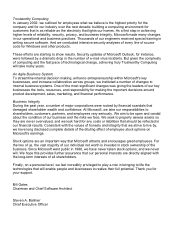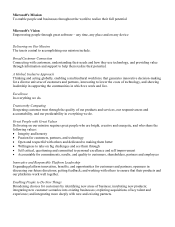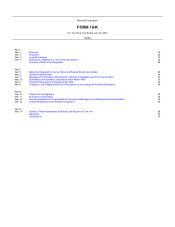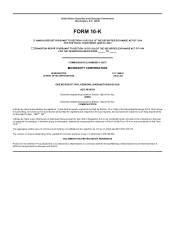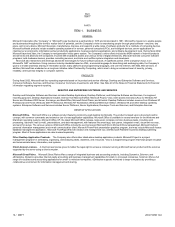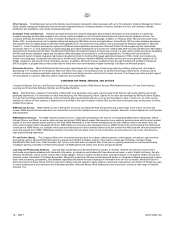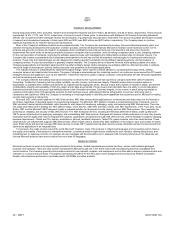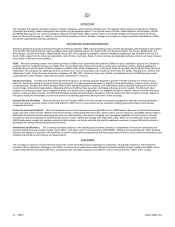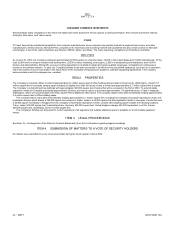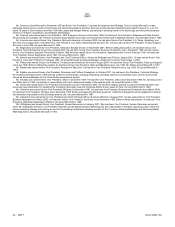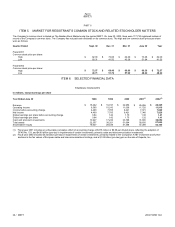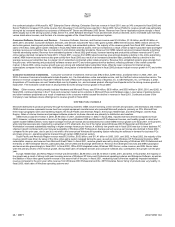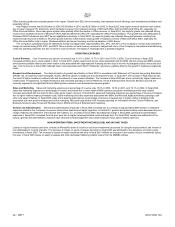Microsoft 2002 Annual Report Download - page 18
Download and view the complete annual report
Please find page 18 of the 2002 Microsoft annual report below. You can navigate through the pages in the report by either clicking on the pages listed below, or by using the keyword search tool below to find specific information within the annual report.
MSFT 20 / 2002 FORM 10-K
Part I
Item 1
PRODUCT DEVELOPMENT
During fiscal years 2000, 2001, and 2002, research and development expense was $3.77 billion, $4.38 billion, and $4.31 billion, respectively. Those amounts
represented 16.4%, 17.3%, and 15.2%, respectively, of revenue in each of those years. In accordance with Statement of Financial Accounting Standards
(SFAS) 142, Goodwill and Other Intangible Assets, the amortization of goodwill was discontinued in fiscal 2002. The amount of goodwill amortization included
in research and development expense in fiscal years 2000 and 2001 was $232 million and $272 million, respectively. The Company plans to continue
significant expenditures for research and product development.
Most of the Company’s software products are developed internally. The Company also purchases technology, licenses intellectual property rights, and
oversees third-party development and localization of certain products. Internal development allows Microsoft to maintain closer technical control over its
products and gives the Company the freedom to designate which modifications and enhancements are most important and when they should be
implemented. Microsoft works on devising innovative solutions to computer science problems, such as making computers easier to use, designing software
for the next generation of hardware, improving the software design process, and investigating the mathematical underpinnings of computer science. The
Company has created a substantial body of proprietary development tools and has evolved development methodologies for creating and enhancing its
products. These tools and methodologies are also designed to simplify a product’s portability among different operating systems, microprocessors, or
computing devices. Product documentation is generally created internally. The Company strives to become informed at the earliest possible time about
changing usage patterns and hardware advances that may affect software design. Before releasing new software platforms, Microsoft provides to software
vendors a range of development, training, testing resources, and guidelines for developing applications.
The software industry is characterized by rapid technological change, which requires constant attention to computing technology trends, shifting
consumer demand, and rapid product innovation. The pace of change is accelerating as the computing needs of our customers move beyond the PC toward
intelligent devices and appliances, such as the Tablet PC. Tablet PCs extend the power of laptop computers running Windows XP with enhanced capabilities
such as handwriting and speech input.
The Company believes that making its products trustworthy is critical to their success and has launched a company-wide effort called Trustworthy
Computing. Trustworthy Computing has four pillars: reliability, security, privacy, and business integrity. Reliability means that a computer system is
dependable, is available when needed, and performs as expected and at appropriate levels. Security means that a system is resilient to attack, and that the
confidentiality, integrity and availability of both the system and its data are protected. Privacy means that individuals have the ability to control data about
themselves and that those using such data faithfully adhere to fair information principles. Business integrity, in this context, is about being responsible to
customers and helping them find appropriate solutions for their business issues, addressing problems with products or services, and being open in
interactions with customers. While the Company is continuing to invest significantly in delivering new capabilities that customers ask for, Microsoft is making
security improvements a high priority.
Microsoft .NET is Microsoft’s platform for XML Web services. XML Web services allow applications to communicate and share data over the Internet or
an intranet, regardless of operating system or programming language. The Microsoft .NET platform includes a comprehensive family of products, built on
XML and other Internet industry standards, which provide for each aspect of developing, managing, using, and experiencing XML Web services. There are
five areas where Microsoft is building the .NET platform today: Tools, Servers, XML Web Services, Clients, and .NET Experiences. In the Tools area, Visual
Studio .NET and the Microsoft .NET framework supply a complete solution for developers to build, deploy, and run XML Web services. They maximize the
performance, reliability, and security of XML Web services. The .NET Enterprise Servers, including the Windows 2000 Server family, make up Microsoft
.NET’s server infrastructure for deploying, managing, and orchestrating XML Web services. Designed with mission-critical performance in mind, they provide
enterprises with the agility they need to integrate their systems, applications, and partners through XML Web services, and the flexibility to adapt to changing
business requirements. Clients are PCs, laptops, workstations, phones, handheld computers, Tablet PCs, game consoles, and other smart devices. These
smart devices use software that supports XML Web services, which enable users to access their data regardless of the location, type, and number of clients
used. Smart clients and devices leverage XML Web services to create .NET experiences that allow users to access information across the Internet and from
stand-alone applications in an integrated way.
To best serve the needs of users around the world, Microsoft “localizes” many of its products to reflect local languages and conventions and to improve
the quality and usability of the product in international markets. Localizing a product might require modifying the user interface, altering dialog boxes, and
translating text. In Japanese versions, for example, all user messages and documentation are in Japanese with monetary references in the Japanese yen.
Various Microsoft products have been localized into more than 30 languages.
MANUFACTURING
Microsoft contracts out most of its manufacturing activities to third parties. Outside manufacturers produce the Xbox, various retail software packaged
products, and hardware. There are other custom manufacturers Microsoft could use in the event outsourced manufacturing becomes unavailable from
current vendors. The Company generally has multiple sources for raw materials, supplies, and components and is often able to acquire component parts and
materials on a volume discount basis. The graphics processing unit (GPU) for the Xbox was custom designed and is produced by NVIDIA Corporation.
Quality control tests are performed on purchased parts, CD-ROMs, and other products.


